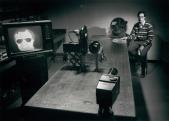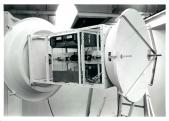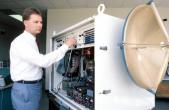In October 1984, on its 50th anniversary, the Engineering Experiment Station officially became the Georgia Tech Research Institute. Its contracting agency, then operating under the name Georgia Tech Research Institute, was renamed the Georgia Tech Research Corporation.
"We're finally calling ourselves what we evolved into years ago," said Director Donald Grace. "But we're not only assuming a new identity, we're also shifting emphasis. While continuing to depend upon our backbone of federal government work, we will be more aggressively seeking industrial research contracts as well."
During the first half of the 1980s, GTRI's projects were comprised of:
- Electronics (66%),
- Energy (15%),
- Domestic and international economic development (9%),
- Computer technology (7%), and
- Physical, chemical, and material sciences (3%).
In 1985, President Ronald Reagan's decision to pursue a missile-defense system-the Strategic Defense Initiative, popularly known as "Star Wars," brought Georgia Tech its largest research contract to date. The $21.3 million award was divided between the School of Electrical Engineering and GTRI.
The same year, the ribbon was cut for the Centennial Research Building. The $12.5 million six-story structure provided desperately needed lab and office space for GTRI's growing research portfolio.
Other highlights of the decade include:
- The opening of a multi-million-dollar electromagnetic radiation measurement range at GTRI's Cobb County research complex,
- The construction of a 95 GHz coherent radar system for studying targets and clutter, and
- The completion of the world’s largest compact range at the U.S. Army Proving Ground at Fort Huachuca, Arizona.
A Landmark Contract
In 1986, GTRI landed the largest-ever contract of its own — a $14.7 million deal to design and build a simulator of a Soviet surface-to-air missile system. The training set included a full emitter-receiver-processor, along with target acquisition and tracking radar, command transmitter, missile tracking radar, and display systems. The huge system was housed in a 40-foot trailer and three 20-foot transportable shelters.
The simulator project underscored GTRI's astonishing progress. Not only was it a worthy engineering challenge, but its $14.7 million budget alone was more than double the entire research budget for both Georgia Tech and the EES in 1972. In fact, in 1985, combined research spending at Georgia Tech and GTRI reached $85 million.
But more than money was to be earned. The next year, the steady climb of Georgia Tech and GTRI toward the spotlight of national recognition was rewarded when the National Science Foundation named Georgia Tech the top university in the country for engineering research and development.








